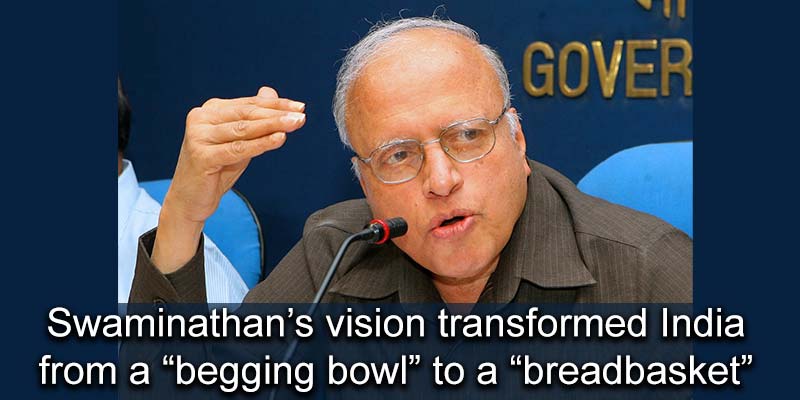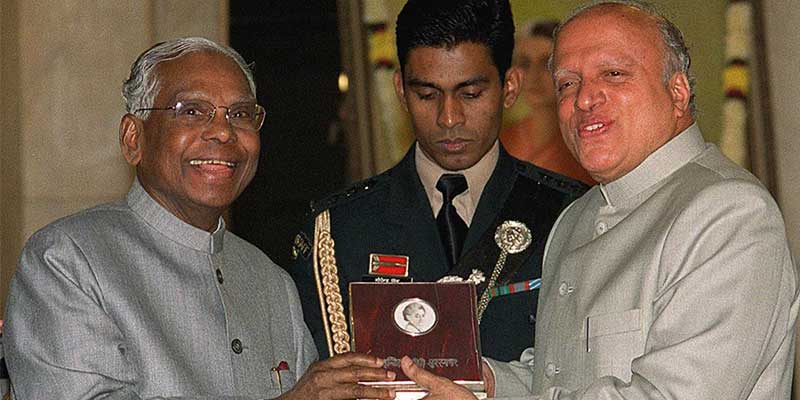- India
- Sep 28
How MS Swaminathan became the architect of India’s ‘Green Revolution’?
• Renowned agricultural scientist Mankombu Sambasivan Swaminathan, popularly known as “the father of Green Revolution in India” passed away in Chennai on September 28. He was 98.
• Green Revolution technology was the key in taking Indian agriculture out of the declining productivity phase in the 1960s, and putting it on a respectable growth path in a short period.
• M.S. Swaminathan was also called the “Father of Economic Ecology” by the United Nations Environment Programme.
• He was born on August 7, 1925 in Kumbakonam, Tamil Nadu.
How India was transformed from a begging bowl to a breadbasket?
• A plant geneticist by training, Swaminathan has made a stellar contribution to the agricultural renaissance of India.
• Agriculture has traditionally been India’s most important economic sector. Over time, it has provided approximately one-third of the country’s gross domestic product (GDP).
• When India attained independence, the agriculture sector was in a poor state. The situation was aggravated by the fact that the more productive and largely irrigated areas fell in the newly-created Pakistan.
• Farmers in India had long suffered from a lack of food security. In the 1960s, it was widely predicted by demographers and economists that population would outstrip food production in developing nations, leading to famine in India and throughout the rest of Asia. At the time, massive shipments of imported grain were the only means by which the continent was averting famine.
• As a young scientist at the Indian Agricultural Research Institute in the 1950s, Swaminathan learned of Dr. Norman Borlaug’s newly developed Mexican dwarf wheat variety and invited him to India.
• These two world‐renowned agricultural scientists met for the first time in 1953 at a conference organised by the American Society of Biological Sciences hosted by the University of Wisconsin‐Madison. Dr. Swaminathan was most intrigued with Borlaug’s presentation about a new method of controlling rust disease in wheat.
• Swaminathan worked closely with Borlaug to bring about the great agricultural transformation. Together they spread high-yielding wheat and rice varieties and improved agricultural practices among the poorest farmers of India.
• Indian consumers did not care for the red colour of the Mexican wheat varieties like ‘Lerma rojo’ for making chapati bread, and so Borlaug provided seeds from his work in Pakistan that were more amber in colour. Swaminathan conducted additional research on these varieties to develop ‘Sonalika’ and ‘Kalyan Sona’, which had the desired chapati‐making quality.
• Swaminathan also created new methods to teach Indian farmers how to effectively increase production by employing a combination of the high-yielding wheat varieties, fertilisers, and more efficient farming techniques.
• Swaminathan set up thousands of demonstration and test plots. The first year’s harvest tripled previous production levels.
• His direct work with farmers overcame the obstacles of illiteracy and lack of formal education and provided a generation of Indians with knowledge about the effectiveness of modern agriculture.
• Through the application of science, education of farmers, famine was averted, and, by the late 1960s, Indian agriculture was on course to self‐sufficiency in cereal grains.
• Swaminathan’s vision transformed India from a “begging bowl” to a “breadbasket”.
• The Green Revolution in India was a period of astounding food production and hunger abatement brought about by scientific discovery and application combined with policy intervention.
• Swaminathan has called the Green Revolution a ‘symphony of ingredients’. One is science, which is the prime mover of change. Another, the gamut of public policies. Third, services such as seed production, electricity, and fertiliser. And finally, farmers’ enthusiasm and toil.
• Norman E. Borlaug was awarded the Nobel Peace Prize in 1970 for a lifetime of work to feed a hungry world.
• Swaminathan was honoured across the globe for his scientific brilliance, his life’s mission of bringing improved technology to citizens at all levels of society, his pioneering advocacy and humanitarianism, and his inspiration to thousands.
Education and Awards
• Swaminathan graduated in BSc Zoology from the Maharajas College (now known as University College, Thiruvananthapuram). He decided to pursue a career in agricultural sciences and enrolled in Madras Agricultural College (now the Tamil Nadu Agricultural University) for BSc. He received MSc degree in Agricultural Sciences (specialising in genetics and plant breeding) from the Indian Agricultural Research Institute (IARI) in 1949 and PhD degree from Cambridge University, UK in 1952.
• Swaminathan joined the faculty of IARI, New Delhi, in 1954. He became the Director of IARI (1961-72), Director General of Indian Council of Agricultural Research (ICAR) and secretary to the government
of India (1972-79), principal secretary in the ministry of agriculture (1979-80), Acting Deputy Chairman and later Member (Science and Agriculture), Planning Commission (1980-82), and Director General, International Rice Research Institute in the Philippines (1982-88).
• Swaminathan was honoured with Padma Shri (1967), Padma Bhushan (1972) and Padma Vibhushan (1989).
• He was awarded the Ramon Magsaysay Award for Community Leadership in 1971, the Albert Einstein World Science Award in 1986, the first World Food Prize in 1987.
• He was a Fellow of many of the leading scientific academies of India and the world, including the Royal Society of London and the US National Academy of Sciences.
• He received more than 80 honorary doctorate degrees from universities around the world.
• He was a Member of the Rajya Sabha for the period 2007-13.
• Other international awards include UNEP Sasakawa Environment Prize in 1994, the UNESCO Gandhi Gold Medal in 1999, the Indira Gandhi Prize for Peace, Disarmament, and Development in 1999 , and the Franklin D. Roosevelt Four Freedoms Award in 2000.
• Time Magazine honoured him as one of the 20 most influential Asians of the 20th century.
• Former United Nations Secretary General Javier Perez Cuellar once hailed Dr. Swaminathan as “a legend who will go into the annals of history as a world scientist of a rare distinction”.
• One of Swaminathan’s most enduring achievements was his creation of the M.S. Swaminathan Research Foundation (MSSRF) in Chennai, using the Prize funds he was awarded. Under his guidance, that center has for decades worked to confront hunger, poverty, social disenfranchisement, and environmental degradation by uniting experts and pioneering projects in disciplines as disparate as aquaculture, gender issues, crop genetics, economics, tropical ecosystems, and information technology.
Manorama Yearbook app is now available on Google Play Store and iOS App Store


